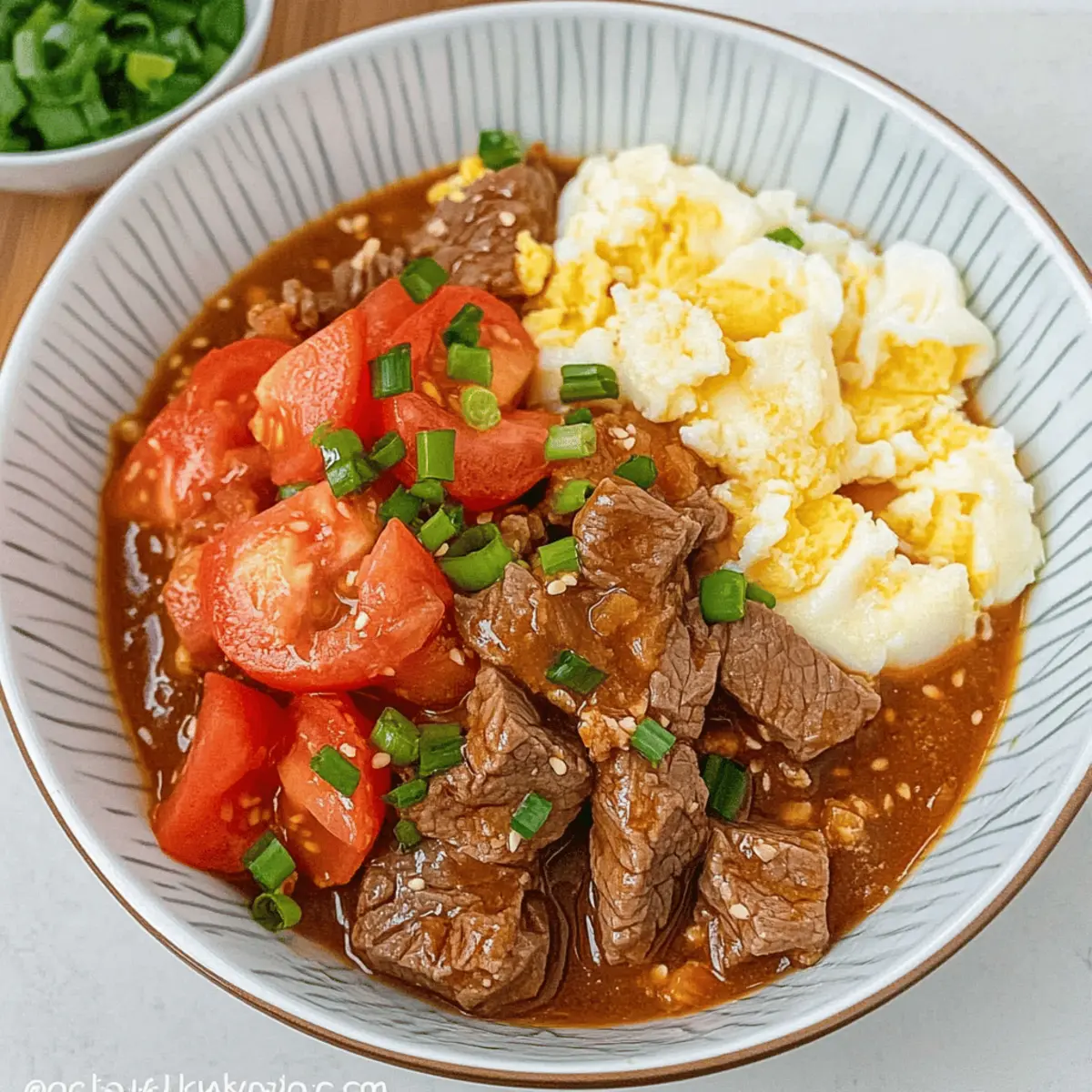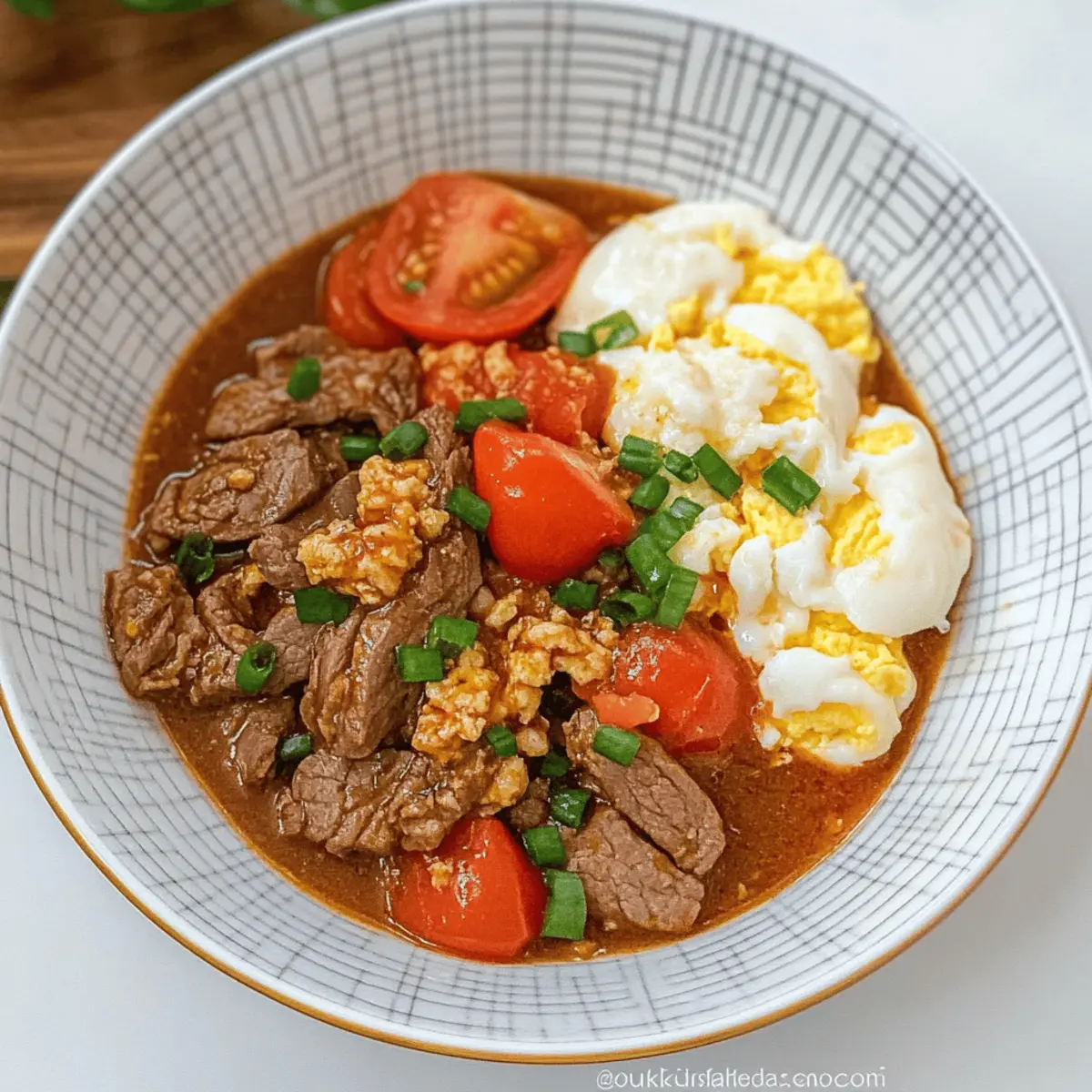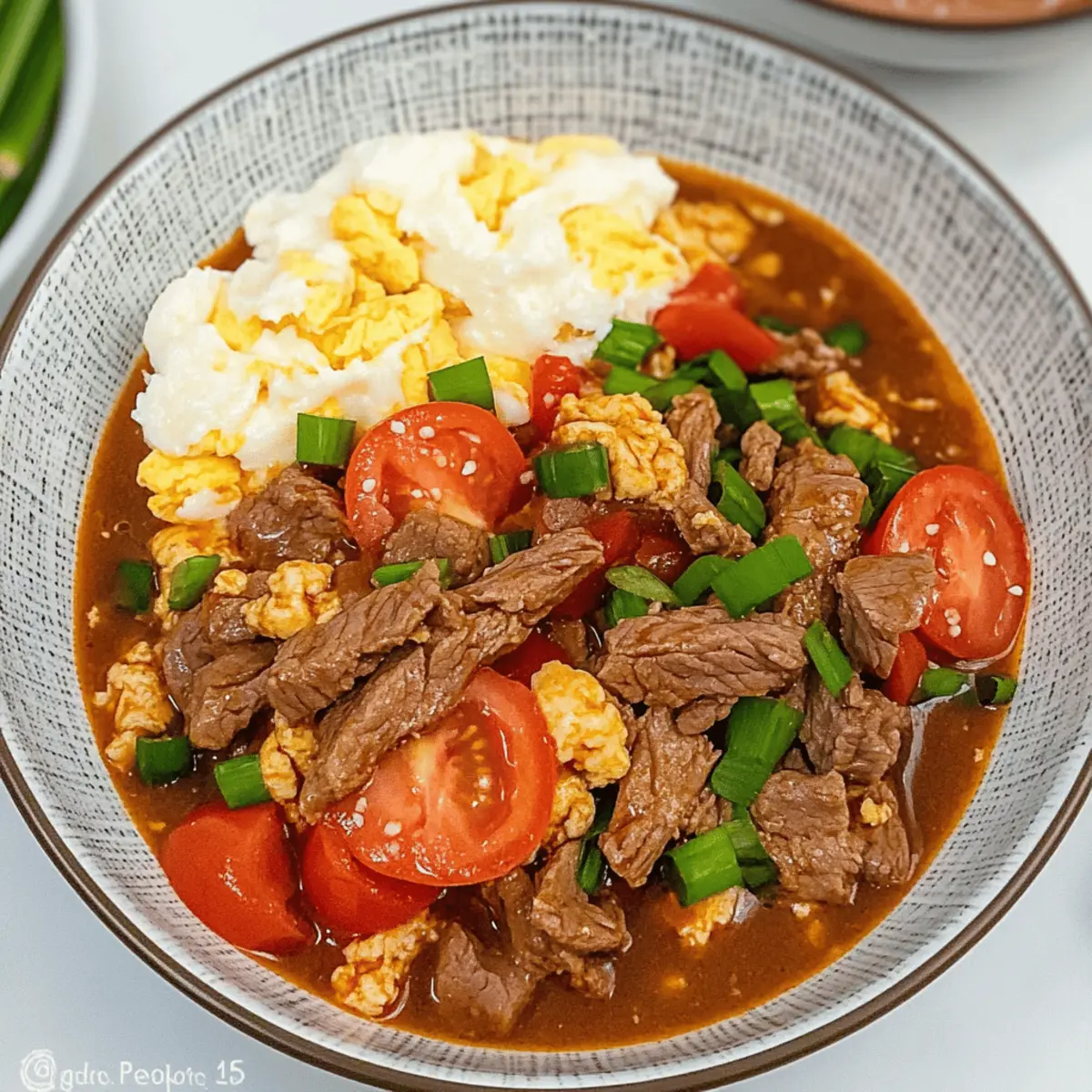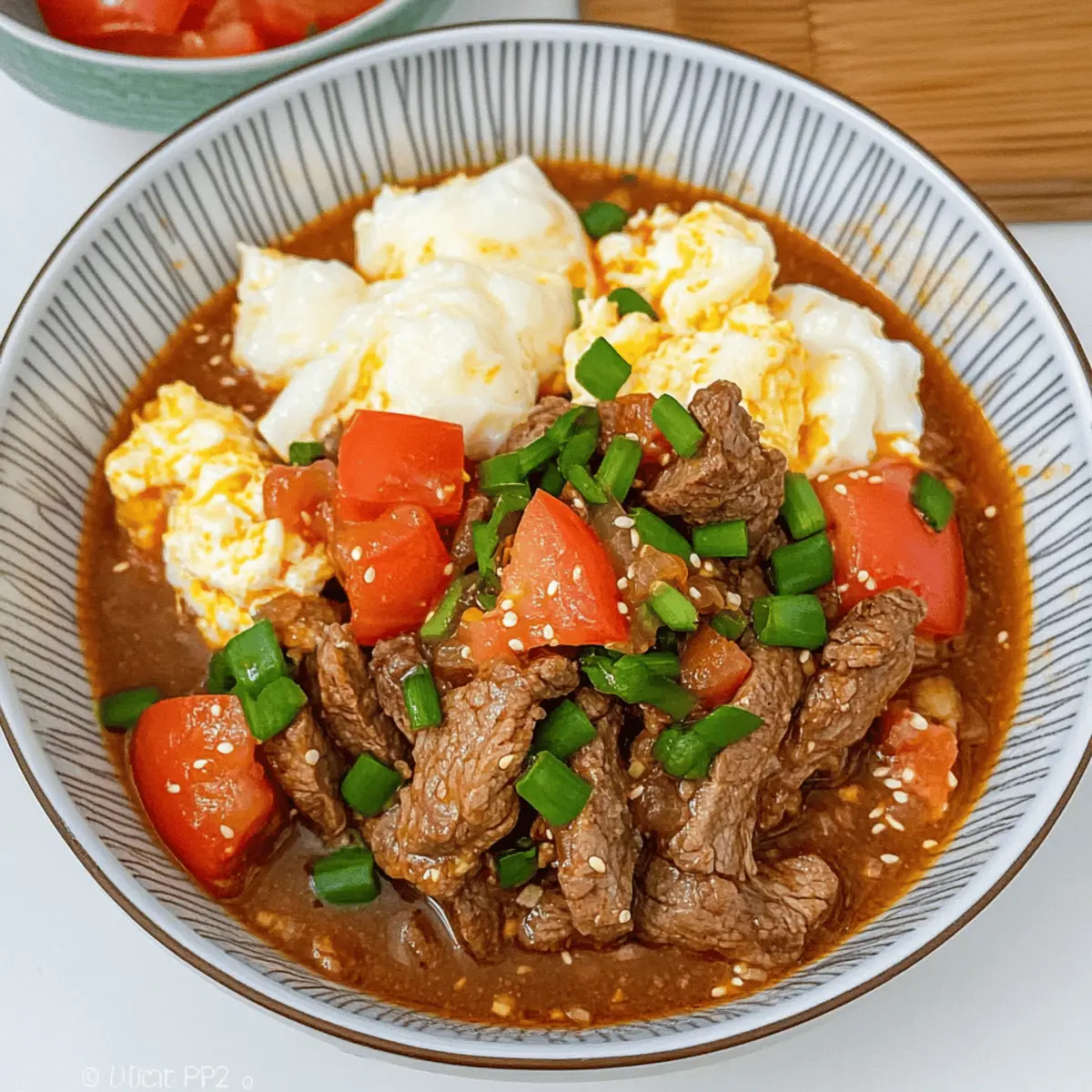The sizzling sound of beef hitting a hot wok instantly transports me to bustling street markets in Asia, where vibrant flavors come alive. Today, I’m excited to share my take on a beloved comfort dish: Chinese Tomato Beef Egg. With savory strips of tender beef, juicy tomatoes, and fluffy scrambled eggs, this quick meal is sure to become a family favorite. In just 30 minutes, you’re set to serve a delightful dish that strikes the perfect balance between sweet and savory—a true weeknight hero. Plus, it’s incredibly versatile; feel free to swap ingredients to suit what you have on hand! Are you ready to whip up this deliciously satisfying meal?

Why Is This Recipe a Must-Try?
Simplicity at Its Core: This Chinese tomato beef egg dish takes just 30 minutes from start to finish—perfect for busy weeknights!
Flavor Explosion: The blend of juicy tomatoes, tender beef, and fluffy scrambled eggs creates a mouthwatering experience that will have everyone asking for seconds.
Family-Friendly Flexibility: Feel free to customize the ingredients based on your family’s preferences; swap beef for tofu or add colorful veggies like bell peppers for an extra crunch.
Comfort Food at Its Best: The harmonious balance of sweet and savory flavors makes this dish not just a meal, but a comforting experience reminiscent of home-cooked goodness.
Appeals to All: Whether you’re a seasoned chef or a kitchen newbie, this recipe promises to impress with its simplicity and bold tastes—pair it with steamed rice or enjoy it alongside some crispy air-fried eggplant for a complete meal.
Chinese Tomato Beef Egg Ingredients
For the Beef
• Sirloin or Flank Steak – Main protein source; ensures a tender texture. Can substitute with chicken or tofu for a lighter version.
• Cornstarch Slurry – Used for marinating beef and thickening sauce. Divide for best results, ensuring meat is tender and sauce is glossy.
• Shaoxing Wine – Adds depth of flavor to the beef. Substitute with dry sherry if unavailable.
For the Sauce
• Vegetable Oil – For stir-frying; provides high smoke point. Olive oil can be used as a substitute.
• Ripe Tomatoes – Main vegetable; gives sweetness and moisture. Ensure tomatoes are juicy for optimal flavor.
• Ketchup/Tomato Paste – Adds tanginess to the sauce. Ketchup is a common choice, but tomato paste can deepen the flavor.
• Light and Dark Soy Sauce – Provides umami and caramel color. Use low-sodium versions for a healthier option.
• Brown Sugar – Balances acidity of tomatoes with sweetness. White sugar can be used in a pinch.
• Beef Broth or Water – Forms the sauce base, influencing depth. Use homemade beef broth for richer flavor.
For the Eggs
• Large Eggs – Essential for scrambling; adds richness. Can use fewer eggs based on preference.
For the Finish
• Green Onions – For garnish and flavor; used in stages for optimal results. White parts for cooking, green parts for finish.
• Salt and Black Pepper – To season the dish to taste. Adjust according to preferences.
• Sesame Oil – For added aroma; optional. Can omit, but enhances the dish’s authenticity.
Step‑by‑Step Instructions for Chinese Tomato Beef Egg
Step 1: Preparation
Start by gathering all your ingredients and chopping them—slice the beef thinly against the grain. In a bowl, marinate the beef with cornstarch, Shaoxing wine, both soy sauces, salt, and pepper, letting it rest for at least 15 minutes. This ensures the beef absorbs the flavors while tenderizing for the delicious Chinese tomato beef egg dish.
Step 2: Scramble Eggs
In a non-stick pan, heat half a tablespoon of vegetable oil over medium heat. Pour in the beaten eggs and gently scramble them, stirring continuously until they’re just set and fluffy, about 2-3 minutes. Once cooked, transfer the scrambled eggs to a plate and set aside, allowing the flavors for the Chinese tomato beef egg to deepen without sticking.
Step 3: Stir-Fry Beef
Next, increase the heat to high and heat 1 tablespoon of vegetable oil in a wok. Add the marinated beef in a single layer to ensure it sears nicely without steaming. Stir-fry for 3-4 minutes until the beef is browned and cooked through. Once ready, remove the beef from the wok and set it aside, keeping it warm while you prepare the sauce.
Step 4: Prepare Sauce
In the same wok, add the remaining oil and sauté the white parts of the green onions for 1-2 minutes, allowing them to soften and release their aroma. Add the tomato wedges, followed by ketchup, brown sugar, and beef broth. Stir the mixture well and bring it to a boil, enticing everyone with the wonderful smell of the Chinese tomato beef egg sauce.
Step 5: Thicken Sauce
Once boiling, reduce the heat to medium-low and stir in the cornstarch slurry gradually. Allow the sauce to simmer for about 5 minutes until it thickens to a glossy consistency. Keep stirring occasionally to ensure it doesn’t stick to the bottom, creating a rich sauce that will coat your Chinese tomato beef egg perfectly.
Step 6: Combine
Return the cooked beef and scrambled eggs to the wok. Gently mix everything together, ensuring the beef and eggs are coated in the flavorful sauce. Heat through for another 1-2 minutes, allowing the flavors to meld and the dish to reach a comforting warmth.
Step 7: Serve
Finally, garnish the dish with the green onion tops for a fresh finish. Serve the Chinese tomato beef egg hot, alongside steamed rice or noodles, to complete the meal. Enjoy the delightful harmony of flavors and textures in this quick weeknight dish!

Expert Tips for Chinese Tomato Beef Egg
-
Hot Wok Secret: Always preheat your wok until it’s smoking hot before adding the beef; this will create a delightful sear that enhances flavor.
-
Cut Against the Grain: Slice the beef against the grain for maximum tenderness. This simple technique makes all the difference in your Chinese tomato beef egg dish!
-
Watch the Sauce Consistency: Don’t rush the thickening process; allow the sauce to simmer and stir regularly. A glossy sauce coats the dish beautifully.
-
Egg Perfection: Scramble the eggs gently and remove them from the heat just before they’re fully cooked—they will continue to set while resting, resulting in soft, fluffy eggs.
-
Customize Your Veggies: Feel free to add veggies like bell peppers or snap peas to your Chinese tomato beef egg for extra crunch and nutrition—just adjust cooking times as needed.
-
Avoid Overcrowding: When stir-frying, make sure not to overcrowd the pan. Cook in batches if necessary to ensure everything cooks evenly and retains its crispness.
How to Store and Freeze Chinese Tomato Beef Egg
Fridge: Store leftovers in an airtight container; they’ll keep fresh for up to 4 days. Make sure to let the dish cool completely before sealing.
Freezer: For longer storage, freeze in a labeled airtight container for up to 3 months. Portioning into smaller servings makes it easier to thaw and reheat.
Reheating: Reheat in the microwave or on the stovetop over low heat. Add a splash of water to the dish and cover it to maintain moisture. Enjoy your delicious Chinese tomato beef egg even after storing!
Room Temperature: Avoid leaving the dish out for more than 2 hours to prevent spoilage. Always refrigerate promptly after cooling.
Make Ahead Options
These Chinese tomato beef eggs are a fantastic choice for meal prep, saving you time on busy weeknights! You can marinade the beef (with cornstarch, Shaoxing wine, soy sauces, salt, and pepper) up to 24 hours in advance; simply store it in an airtight container in the refrigerator. Additionally, you can scramble the eggs and keep them in the fridge for up to 3 days—this helps maintain that fluffy texture when mixed back in. When it’s time to serve, stir-fry the beef and follow the remaining cooking steps quickly. This ensures your dish is just as delicious as when freshly made, allowing you to enjoy a comforting meal with minimal effort!
What to Serve with Quick & Flavorful Chinese Tomato Beef and Eggs
Steaming bowls of fluffy rice and a medley of vibrant sides make this dish truly shine in any meal.
-
Steamed Jasmine Rice: This aromatic rice absorbs the delicious sauce, balancing flavors beautifully while adding a comforting touch.
-
Stir-Fried Bok Choy: Crisp and vibrant, this vegetable brings a refreshing crunch while complementing the rich savory notes of the beef.
-
Crispy Spring Rolls: Filled with crunchy vegetables and served with a sweet chili dip, spring rolls add texture and a light contrast.
-
Garlic Broccoli: Tender broccoli with a garlic glaze elevates the meal’s flavor while offering a nutritious green boost.
-
Egg Fried Rice: Rich and savory, this side is a perfect way to soak up all the flavorful sauce from the Chinese tomato beef egg.
-
Chilled Cucumber Salad: This refreshing salad provides a cooling element to the dish, balancing the warmth and richness perfectly.
-
Chardonnay: A chilled glass of this white wine pairs beautifully with the sweetness of the tomatoes and the hearty beef.
-
Mango Sticky Rice: For dessert, this sweet, creamy treat brings a delightful end to the meal, enhancing the Asian-inspired theme.
Chinese Tomato Beef Egg Variations
Feel free to get creative with this delightful dish—your kitchen, your rules!
-
Vegetable Boost: Add chopped bell peppers or snap peas for a colorful crunch that enhances both taste and nutrition. The extra veggies bring brightness to your plate!
-
Protein Swap: Replace beef with minced chicken or tofu for a lighter alternative that’s just as satisfying. Tofu absorbs flavors beautifully—perfect for a plant-based twist!
-
Flavor Enhancement: Integrate minced garlic or ginger into your sauce for a fragrant and aromatic boost. These additions elevate the dish with warm, inviting scents that will entice anyone to the table.
-
Saucy Variation: Try using fresh salsa instead of ketchup for a zesty kick in your sauce. This twist imparts a fresh flavor profile that’s exciting and unexpected!
-
Spice it Up: For a little heat, add sliced chili peppers or a pinch of red pepper flakes during cooking. The warmth balances the sweetness of the tomatoes, making every bite a thrilling experience!
-
Egg Texture Update: Consider making an omelet instead of scrambling the eggs. Fold the eggs into the dish at the end for a beautiful presentation and a slightly different texture that complements the dish.
-
Savory Finish: Drizzle some oyster sauce over the top just before serving for umami richness. This last-minute addition creates a decadent touch that your family will love!
-
Herb Infusion: Toss in fresh basil or cilantro as a garnish for an herbaceous lift that brightens up this hearty meal. Fresh herbs provide a refreshing contrast to the savory elements of the dish.
Explore these variations to find your favorite combination! If you’re in the mood for a tasty side dish, consider pairing your Chinese tomato beef egg with crispy air-fried eggplant for an exquisite culinary journey. Enjoy experimenting with flavors!

Chinese Tomato Beef Egg Recipe FAQs
What type of tomatoes should I use for this recipe?
Absolutely! For the best flavor, use ripe, juicy tomatoes. Look for those that are firm yet slightly soft when squeezed, and avoid any that have dark spots all over. If you can’t find fresh tomatoes, canned tomatoes can also work in a pinch, though fresh will provide a vibrant taste that enhances your Chinese tomato beef egg dish.
How should I store leftovers?
I’m glad you asked! Store any leftovers in an airtight container in the fridge for up to 4 days. Make sure the dish has cooled completely before sealing. This helps retain flavor and prevents any rapid spoilage—keeping your Chinese tomato beef egg as delicious as the first day!
Can I freeze this dish?
Yes, you can! For longer storage, freeze your Chinese tomato beef egg in a labeled airtight container for up to 3 months. When you’re ready to enjoy it again, simply thaw it in the refrigerator overnight. To reheat, pop it in the microwave or on the stovetop—just add a splash of water to maintain moisture.
What if my sauce isn’t thickening properly?
If you’re finding that your sauce isn’t thickening as it should, don’t worry! Start by ensuring you’re using enough cornstarch in your slurry. Mix 1 tablespoon of cornstarch with an equal part of cold water until smooth, then gradually stir it into your simmering sauce. Let it simmer for about 5 minutes, and if it’s still not thickening, give it a good stir and add a touch more cornstarch. This should do the trick!
Are there any dietary considerations I should know about?
Very much so! If you’re cooking for someone with allergies, keep in mind that soy sauce contains gluten. Look for low-sodium or gluten-free soy sauce alternatives like tamari. Also, if you have anyone allergic to eggs, you might want to try substituting them with scrambled tofu for a similar texture in the Chinese tomato beef egg. Be sure to account for any other personal dietary needs, and always feel free to customize!

Savory Chinese Tomato Beef Egg in 30 Minutes or Less
Ingredients
Equipment
Method
- Start by gathering all your ingredients and chopping them—slice the beef thinly against the grain. In a bowl, marinate the beef with cornstarch, Shaoxing wine, both soy sauces, salt, and pepper, letting it rest for at least 15 minutes.
- In a non-stick pan, heat half a tablespoon of vegetable oil over medium heat. Pour in the beaten eggs and gently scramble them, stirring continuously until they're just set and fluffy, about 2-3 minutes. Once cooked, transfer the scrambled eggs to a plate and set aside.
- Increase the heat to high and heat 1 tablespoon of vegetable oil in a wok. Add the marinated beef in a single layer. Stir-fry for 3-4 minutes until browned and cooked through. Remove from the wok and keep warm.
- In the same wok, add the remaining oil and sauté the white parts of the green onions for 1-2 minutes. Add the tomato wedges, ketchup, brown sugar, and beef broth. Stir and bring to a boil.
- Once boiling, reduce heat to medium-low and stir in the cornstarch slurry gradually. Allow to simmer for about 5 minutes until it thickens to a glossy consistency.
- Return the cooked beef and scrambled eggs to the wok. Gently mix together, ensuring everything is coated in the sauce. Heat through for another 1-2 minutes.
- Garnish with the green onion tops and serve hot, alongside steamed rice or noodles.

Leave a Reply